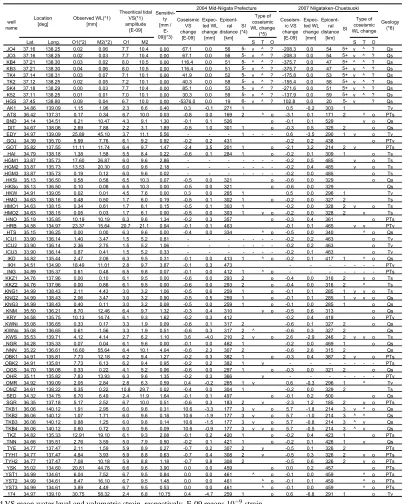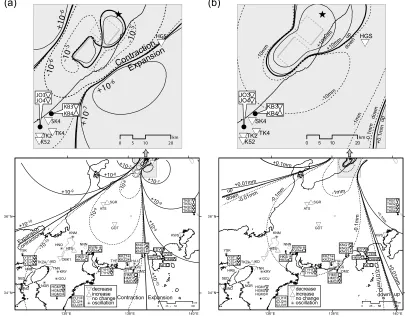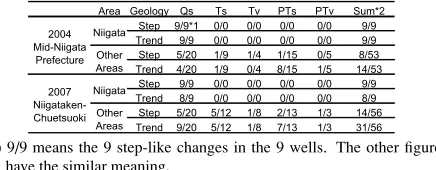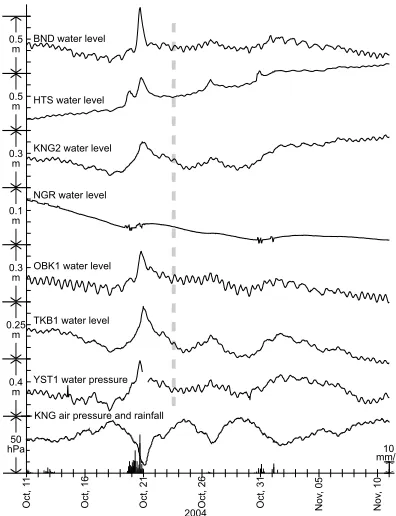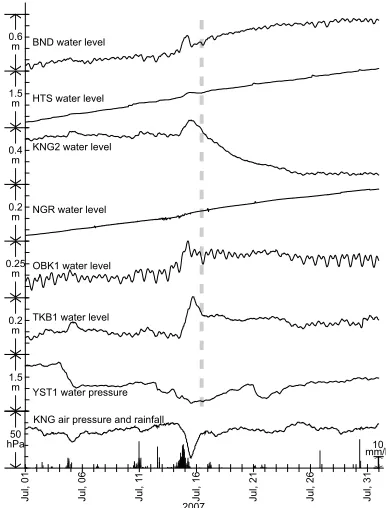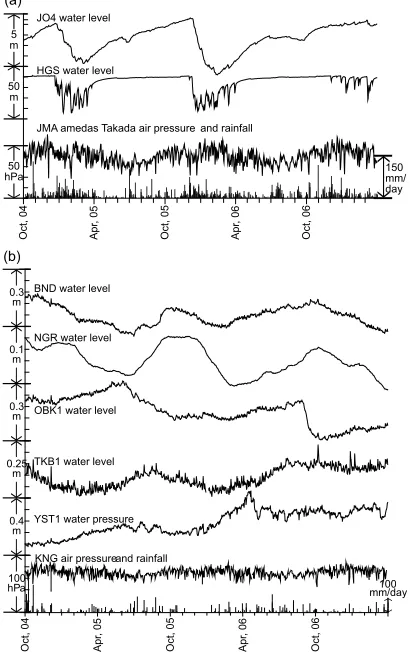Groundwater changes associated with the 2004 Niigata-Chuetsu and 2007
Chuetsu-oki earthquakes
Satoshi Itaba1, Naoji Koizumi1, Tsuyoshi Toyoshima2, Masashi Kaneko3, Kazuyoshi Sekiya3, and Kunio Ozawa4
1Geological Survey of Japan, National Institute of Advanced Industrial Science and Technology (AIST), 1-1-1 Higashi, Tsukuba, Ibaraki, Japan
2Graduate School of Science and Technology Earth Science, Niigata University, Japan 3Niigata Prefectural Government, Japan
4Disaster Prevention Bureau, Shizuoka Prefectural Government, Japan
(Received December 17, 2007; Revised May 1, 2008; Accepted May 7, 2008; Online published December 10, 2008)
The Geological Survey of Japan, AIST, has been monitoring groundwater in and around the Kinki and Tokai districts for earthquake prediction research. The Niigata Prefectural Office has also been observing groundwater for monitoring land subsidence in Niigata Prefecture. The 2004 Niigata-Chuetsu (MJMA6.8) and 2007
Chuetsu-oki (MJMA6.8) earthquakes occurred in Niigata Prefecture, Japan, on October 23, 2004 and July 16, 2007,
respectively. The two earthquakes have a similar magnitude, epicenter, and mechanism. At many of the observation wells, we detected changes in groundwater level or pressure related to the two earthquakes, but no clear precursory changes. At all of our observation wells in Niigata Prefecture, trend changes were observed after coseismic step-like changes for both of the earthquakes. At some of the stations in and around the Kinki and Tokai districts, coseismic trend changes and/or step-like changes were observed. The pattern of the changes were almost similar for the two earthquakes. Those changes were considered to be caused not by the static crustal deformation but by the ground shaking.
Key words: Groundwater, strain, coseismic change, ground shaking, 2007 Chuetsu-oki earthquake, 2004 Niigata-Chuetsu earthquake, long-term stability of groundwater.
1.
Introduction
Earthquakes cause ground shaking and static crustal deformation. Therefore, earthquake-related groundwater changes are considered to be caused by the ground shak-ing and static crustal deformation. Accordshak-ing to the poro-elastic theory (Biot, 1941; Roeloffs, 1996), stress, strain, pore pressure, and water content are related to each other. On the basis of this knowledge, Montgomery and Manga (2003) pointed out that there are two main factors for earthquake-related groundwater change. One is the static volumetric strain change and the other is ground shak-ing, which includes the dynamic volumetric strain change. In addition, static earthquake-related displacement of the crust, especially the vertical displacement, can also have some effect on groundwater. However, the amplitude of the ground motion decreases in inverse proportion to the hypocentral distance for the body wave or route of the epi-central distance for surface wave, while the amplitude of static volumetric strain change and static displacement, re-spectively, decreases in inverse proportion to the cubic and square of the hypocentral distance. Therefore, in the neigh-borhood of the focal region, we have to consider the ef-fects of both static crustal deformation and ground shaking. However, in the area far enough from the focal region, the
Copyright cThe Society of Geomagnetism and Earth, Planetary and Space Sci-ences (SGEPSS); The Seismological Society of Japan; The Volcanological Society of Japan; The Geodetic Society of Japan; The Japanese Society for Planetary Sci-ences; TERRAPUB.
effect of static crustal deformation is much smaller than that of the ground shaking and can be neglected. For unconfined groundwater, whose strain sensitivity is very low (Brede-hoeft, 1967), the effect of the volumetric strain changes can usually be neglected.
For any evaluation of the long-term stability of ground-water in Japan, it is important to investigate earthquake-related changes, their recoveries, and reproducibility. The magnitude, hypocenter, and mechanism of the 2004 Niigata-Chuetsu and 2007 Chuetsu-oki earthquakes are al-most the same, although they are large and disastrous earth-quakes. Therefore, distributions of the seismic intensities and coseismic static crustal deformation of the two earth-quakes are large and similar, and they occurred within a few years of each other. It is a very rare case. Therefore, it seems meaningful to investigate the earthquake-related groundwater changes for the two earthquakes, even though only two cases are not enough to check the reproducibility. In this paper, we will discuss the earthquake-related ground-water level (or pressure) changes and their recoveries based on the groundwater level data in Niigata Prefecture or in the neighborhood of the focal region and those in and around the Tokai and Kinki districts, which are far from the focal region.
2.
Observation
Since Niigata Prefecture produces oil and natural gas, many boring tests have been performed. Those tests show that high-pressure thermal water, whose pressure is shifted
(∗1) WL and VS mean water level and volumetric strain, respectively. E-09 means 10−9strain. (∗2) O1 and M2 denote tidal components. The period of O1 and M2 is 25.8 h and 12.4 h, respectively. (∗3) The average of the strain sensitivities for O1 and M2 components.
(∗4) SI means the seismic intensity in the scale of the Japan Meteorological Agency. 5−, 5+and 6−mean ‘5 lower’, ‘5 upper’ and ‘6 lower’, respectively.
(∗5) S+ˆ is step up, S+v is step down, T+ˆ is trend up and T+v is trend down and O is oscillation, respectively. ‘—’ means there were no data when the earthquake occurred.
(∗6) Qs: Quaternary sediments or sedimentary rocks, Ts: Tertiary sedimentary rocks, Tv: Tertiary volcanic rocks, PTs: Pre-Tertiary sedimentary rocks, PTv: Pre-Tertiary volcanic rocks.
from hydrostatic pressure to lithostatic one, exists under the Niigata sedimentary basin at a depth of 1.5 km or deeper (Xuet al., 1998). Xu et al. (1998) and Okiet al. (1999) pointed that the effect of the high-pressure thermal water was recognized in shallow groundwater in Niigata prefec-ture based on their survey of the temperaprefec-ture and water-quality of groundwater and suggested that the high-pressure
thermal water rises up along active faults in Niigata Prefec-ture and makes a significant contribution to local seismic activity.
Fig. 1. Coseismic groundwater level changes in response to the 2004 Niigata-Chuetsu earthquake. Contours denote the coseismic volumetric strain changes (a) and vertical surface displacements (b) calculated from the dislocation model of the Geographical Survey Institute (2005).
ture, 2008). In order to monitor the land subsidence, the Ni-igata Prefectural Office has been observing the groundwater level since the 1960’s. In Joetsu city and Nagaoka city, there are nine observation wells of Niigata Prefectural Office (Ta-ble 1, Figs. 1 and 2). The sampling interval is 1 h. Geology in and around these observation wells is mainly composed of Quaternary sediments. The nine wells are considered to be situated in the neighborhood of the focal region of the 2004 Niigata-Chuetsu and 2007 Chuetsu-oki earthquakes.
The Geological Survey of Japan (GSJ), AIST has also been monitoring groundwater since 1970’s—for earthquake prediction research. The groundwater observation network of GSJ is now composed of 43 stations (60 wells) in and around the Tokai and Kinki districts (Table 1, Figs. 1 and 2). Some of the groundwater observation stations have two or more observation wells. Therefore, the number of wells is larger than that of the stations. At each station except AK1, the groundwater level in open well or the pressure in the sealed well is observed as pore water pressure in the aquifer. At AK1, the flow rate is observed. For convenience, the data of the groundwater pressure are expressed as those of the groundwater level in this paper. The sampling interval is 2 min for most of the wells and 10 min or 1 s for some of the wells. Most of GSJ wells seem to be far enough from the focal regions for the two earthquakes (Figs. 1 and 2).
To discuss changes in groundwater level or pressure caused by the coseismic static volumetric strain changes, we need the sensitivity of the groundwater level or pressure to volumetric strain changes and the values of the coseis-mic static volumetric strain changes. As to the groundwater level or pressure changes caused by the coseismic static dis-placements, we assume that the amplitudes are smaller than the coseismic vertical displacements of the surface. There-fore, we need the fault models of the two earthquakes to calculate the strain changes and vertical displacements at each of the observation wells.
For the 2004 Niigata-Chuetsu and 2007 Chuetsu-oki earthquakes, various fault models have been reported. Since observed groundwater is shallower than 1 km, we should compare the groundwater level or pressure changes with the static crustal deformation near the ground surface. There-fore, the fault model based on coseismic displacement of the surface is considered to be suitable and we adopted the dis-location models of the Geographical Survey Institute (2005, 2008) in this paper. Using the models, we calculated the coseismic static volumetric strain changes and vertical dis-placements at each well using a program of Okada (1992) and MICAP-G (Naito and Yoshikawa, 1999). At the nine
quake using the BAYTAP-G program (Tamuraet al., 1991). The amplitude of the tidal volumetric strain at each observa-tion well, which includes the components of the earth and oceanic tides, was calculated using the GOTIC2 program (Matsumotoet al., 2001). From these estimated tidal com-ponents, the groundwater level (or pressure) sensitivity at each observation well was determined. The expected wa-ter level change caused by the coseismic volumetric strain change can be calculated when this sensitivity is multiplied by the coseismic volumetric strain change calculated above. Since the resolution of the groundwater level (or pressure) data ranges from 0.1 to 1 mm, the strain sensitivity is re-garded as 0 in the case that the amplitude of the groundwa-ter level for O1 or M2 is smaller than 0.1 mm. The results are shown in Table 1.
Some observed groundwater in Niigata Prefecture should be confined (Sekiya and Miyajima, 2005). However, the barometric response of the groundwater level is ambiguous, and the strain sensitivity is zero at all of the wells in Ni-igata Prefecture (Table 1). Therefore, we should neglect the effect of the static volumetric strain changes on the ground-water level in Niigata Prefecture.
3.
Results
In the 2004 Niigata-Chuetsu and 2007 Chuetsu-oki earth-quakes, the distributions of the volumetric strain changes and vertical surface displacements were similar in and around the Kinki and Tokai districts, but different in Niigata Prefecture (Figs. 1 and 2). All of the wells except HGS in Niigata Prefecture were in the expansion area in the case of the 2004 Niigata-Chuetsu earthquake but in the contraction area in the case of the 2007 Chuetsu-oki earthquake (Figs. 1 and 2, Table 1). As to the vertical displacements, the wells except HGS in Niigata Prefecture were coseismically sunk
Table 2. Earthquake-related groundwater level (pressure) changes classi-fied by geology of the aquifers of the observation wells.
(∗1) 9/9 means the 9 step-like changes in the 9 wells. The other figures have the similar meaning.
for both of the earthquakes while HGS rose for the 2004 Niigata-Chuetsu earthquake. The amplitudes of the verti-cal displacements were smaller than 10 mm except the case of HGS for the 2004 Niigata-Chuetsu earthquake, where the amplitude was a few centimeters (Fig. 1). These were smaller than 1 mm or 0.1 mm at GSJ wells. Since they were much smaller than the observed earthquake-related ground-water level changes, the effect of the static displacements can be neglected for the two earthquakes. The seismic intensity distributions were similar for both of the earth-quakes. At the wells in Niigata Prefecture, the intensity ranges from ‘5 lower’ to ‘6 lower’ in the scale of the Japan Meteorological Agency (JMA). At GSJ wells, it ranges from 0 to 3 (Table 1).
The earthquake-related groundwater changes seem to de-pend on the geology of the aquifer. Table 2 shows the re-lation between the earthquake-related groundwater changes and geology of the aquifer for the wells. The observation wells in Niigata area are all situated in quaternary sediments or sedimentary rocks (Qs in Tables 1 and 2), and the re-sponses for the two earthquakes are almost the same. There-fore, we could not find the differences derived from the ge-ology. However, geology of the Pre-Tertiary sedimentary rocks (PTs) for the observation wells of GSJ seem to pro-duce more trend changes than step-like changes although the other geologies did not show any clear tendencies (Ta-ble 2).
3.1 Groundwater changes in Niigata Prefecture
The observed original groundwater level changes related to the two earthquakes in Niigata Prefecture are shown in Figs. 3 and 6 and Table 1. For air pressure and rainfall, we
Fig. 3. Observed water level changes at Niigata Prefecture before and after the 2004 Niitata-Chuetsu earthquake. The sampling interval is 1 h.
Fig. 4. Examples of observed water level (or pressure) changes at GSJ wells before and after the 2004 Niitata-Chuetsu earthquake. The sam-pling interval is 1 h.
Fig. 5. Examples of observed water level (or pressure) changes at GSJ wells before and after the 2004 Niitata-Chuetsu earthquake. The sam-pling interval is 2 min.
used the data at amedas TAKADA of the JMA.
dis-Fig. 6. Observed water level changes at Niigata Prefecture before and after the 2007 Chuetsu-oki earthquake. The sampling interval is 1 h.
Fig. 7. Examples of observed water level (or pressure) changes at GSJ wells before and after the 2007 Chuetsu-oki earthquake. The sampling interval is 1 h.
tances. Therefore, it is hard to consider that those changes are derived from the focal regions of the two earthquakes. We considered them to be caused by the rainfalls and air pressure changes just before the two earthquakes.
At all of the wells, there were quick rises or drops
im-Fig. 8. Examples of observed water level (or pressure) changes at GSJ wells before and after the 2007 Chuetsu-oki earthquake. The sampling interval is 2 min.
mediately after the two earthquakes, which will be called ‘step-like changes’ in this paper. There were also postseis-mic gradual increases or decreases, which will be called trend changes in this paper. The trend changes continued for several days or longer. The coseismic and postseismic groundwater level changes, which ranged from 0.5 to 3 m, were caused by the ground shaking as mentioned above. The changes at all wells except HGS are very similar for the two earthquakes. The reason for the response at HGS is unknown at present.
3.2 Groundwater changes at GSJ wells
The typical examples of the observed groundwater level (or pressure) changes related to the two earthquakes at GSJ wells, which are far from the focal region, are shown in Figs. 4, 5, 7, and 8 and Table 1. At many of the wells, we detected the small step-like changes and/or trend changes. The groundwater level (or pressure) changes expected from the coseismic volumetric strain changes are smaller than 1 mm at most of the wells and several millimeters at the other wells (Table 1). On the other hand, observed coseis-mic and/or postseiscoseis-mic changes are much larger than the expected changes. Therefore, it is considered that the co-seismic and/or postco-seismic groundwater level (or pressure) changes were caused by the ground shaking. However, the changes are much smaller than those at the wells in Niigata Prefecture. The coseismic and/or postseismic changes are also similar for the two earthquakes although these are not so remarkable as in Niigata Prefecture (Table 1).
3.3 Recovery of earthquake-related groundwater changes
Fig. 9. Examples of the long-term water level changes at the wells in Niigata Prefecture (a) and GSJ wells (b). The sampling interval is 1 day.
since much groundwater is pumped up to melt snow in win-ter, in general, the groundwater level falls greatly in winter and recovers in the other seasons. As a result, there are clear annual changes, the amplitudes of which range from 4 to 30 m. Groundwater level changes related to the two earthquakes were much smaller than these annual changes. It is difficult to detect coseismic and/or postseismic changes related to the 2004 Niigata-Chuetsu earthquake on October 23, 2004 in Fig. 9(a). Therefore it seems that the groundwa-ter level changes related to the 2004 Niigata-Chuetsu earth-quake recovered in Niigata Prefecture before March, 2007. At the observation wells of GSJ in and around the Tokai and Kinki districts, coseismic and/or postseismic changes were small for the two earthquakes. It is also difficult to detect the earthquake-related changes in the long-term groundwater level changes in Fig. 9(b). They seem to have recovered promptly (Figs. 4 and 7).
Since ground shaking can change physical properties, such as permeability, specific storage, and skempton coef-ficient, which govern groundwater movement, it is consid-ered that it may take long time to recover earthquake-related groundwater changes caused by the ground shaking. On the other hand, the coseismic static volumetric strain change, which is usually too small to break the aquifer system, can-not change the physical properties and it may take only a short time to recover the earthquake-related groundwater changes. The 11-m drop of groundwater level at a well in
the Dogo hot spring, which is considered to be caused by the static volumetric strain change due to the 1946 Nankai earthquake, recovered in about 3 months (Kawabe, 1991) although the 10 m rise of the groundwater level at the same well, which is considered to be caused mainly by the ground shaking of the 2001 Geiyo earthquake, has not been recov-ered (Itaba and Koizumi, 2007).
In the case of the 2004 Niigata-Chuetsu and 2007 Chuetsu-oki earthquakes, most of the groundwater level or pressure changes are considered to be caused by ground shaking and we could not find the differences of the re-covery times which may depend on the mechanism of earthquake-related groundwater changes.
4.
Discussion
As mentioned above, it is considered that the groundwa-ter level or pressure changes of our observation wells asso-ciated with the 2004 Niigata-Chuetsu and 2007 Chuetsu-oki earthquakes were caused by ground shaking. The ground shaking causes consolidation, fracturing, and fracture clear-ing (e.g., Montgomery and Manga, 2003; Brodsky et al., 2003). According to Montgomery and Manga (2003), con-solidation is caused also by crustal stress change. Generally, when liquefaction arises, pore pressure will rise. When con-solidation, fracturing, and/or fracture clearing occur, per-meability and specific storage (quantity of the water stored per unit volume), which govern groundwater movement, will be changed. When permeability and storage coefficient are changed, pore pressure distribution in the aquifer will be changed.
In Niigata Prefecture, the groundwater level drops at all of the wells except KB4 immediately after the two earth-quakes (Figs. 3 and 6). This means that pore pressure fell at those wells immediately after the two earthquakes. When fracturing and/or fracture clearing arise, the specific storage can increase momentarily and the pore pressure may fall lo-cally. On the other hand, liquefaction may have occurred at KB4. With respect to the postseismic gradual increases at all wells except HGS, it is considered that they were caused by diffusion, resulting in the new pore pressure distribution in the whole aquifer. It depends on changes in permeability and specific storage in the whole aquifer system. However, as the effect of such changes are much smaller than that of pumping up in winter, it seems that the earthquake-related changes recovered soon.
Fig. 10. Observation waveform of the seismograph and water pressure at HGM. The sampling of seismograph and water pressure are 200 and 1 Hz, respectively.
the surface wave arrived. Brodsky et al. (2003) showed the same result at a well in granite in Oregon USA, and she explained this result as being caused by fracture clean-ing made by the rapid groundwater flow induced by the surface wave. Our result shows that fracture cleaning can occur not only in granite but also in Tertiary sedimentary rocks. If we accumulate such observation results, we will understand the mechanisms of earthquake-related ground-water changes more easily. We plan to increase those high-sampling groundwater observation wells.
5.
Conclusions
We have investigated the groundwater changes in Niigata Prefecture and in and around the Kinki and Tokai districts related to the 2004 Niigata-Chuetsu and 2007 Chuetsu-oki earthquakes. We regarded Niigata Prefecture as the neigh-borhood of the focal region and the area in and around the Kinki and Tokai districts as the area far from it. The static crustal deformations for the two earthquakes were different in Niigata Prefecture, but similar in and around the Kinki and Tokai districts. The distributions of the seismic inten-sities were similar for both of the earthquakes. There was no remarkable precursory change in the groundwater level or pressure. There were many coseismic and/or postseis-mic groundwater level or pressure changes and these were almost similar for the two earthquakes. In Niigata Prefec-ture, the amplitude of coseismic and postseismic water level changes, which were caused by the ground shaking, ranged from 0.5 to 3 m, but these changes were much smaller than the annual changes. In and around the Kinki and Tokai dis-tricts, observed coseismic and postseismic changes, which were also caused by the ground shaking, were small and it seems that they recovered soon. At a certain station in the Kinki district, the step-like change in the groundwater pres-sure started at the arrival time of the surface wave of the 2007 Chuetsu-oki earthquake.
Acknowledgments. We thank Dr. Brodsky and an anonymous re-viewer for valuable comments to improve this paper. We are
grate-tion,73, 269–317, 2005 (in Japanese).
Geographical Survey Institute, Crustal Movements in the Hokuriku and Chubu Districts,Report of The Coordinating Committee for Earthquake Prediction,79, 403–477, 2008 (in Japanese).
Itaba, S. and N. Koizumi, Earthquake-related Changes in Groundwater levels at the Dogo Hot Spring, Japan,Pure Appl. Geophys.,164, 2397– 2410, 2007.
Kawabe, I., Hydro-geochemical anomalies associated with earthquakes,J. Seismol. Soc. Jpn.,44, 341–364, 1991 (in Japanese).
Matsumoto, K., T. Sato, T. Takanezawa, and M. Ooe, GOTIC2: A Program for Computation of Oceanic Tidal Loading Effect,J. Geod. Soc. Jpn., 47, 243–248, 2001.
Matsumoto, S., Y. Iio, T. Matsushima, K. Uehira, and T. Shibutani, Imag-ing of S-wave reflectors in and around the hypocentral area of the 2004 mid Niigata Prefecture Earthquake (M6.8),Earth Planets Space,57, 557–561, 2005.
Montgomery, D. R. and M. Manga, Streamflow and Water Well Responses to Earthquakes,Science,300, 2047–2049, 2003.
Naito, H. and S. Yoshikawa, A Program to Assist Crustal Deformation Analysis,Zisin,52, 101–103, 1999 (in Japanese).
Niigata Prefecture, The present conditions and problems of land subsidence in Niigata Prefecture, http://www.pref.niigata.lg.jp/ kankyotaisaku/1192033843963.html, 2008 (in Japanese).
Okada, T., N. Umino, T. Matsuzawa, J. Nakajima, N. Uchida, T. Nakayama, S. Hirahara, T. Sato, S. Hori, T. Kono, Y. Yabe, K. Ariyoshi, S. Gamage, J. Shimizu, J. Suganomata, S. Kita, S. Yui, M. Arao, S. Hondo, T. Mizukami, H. Tsushima, T. Yaginuma, A. Hasegawa, Y. Asano, H. Zhang, and C. Thurber, Aftershock distribution and 3D seis-mic velocity structure in and around the focal area of the 2004 mid Niigata prefecture earthquake obtained by applying double-difference tomography to dense temporary seismic network data,Earth Planets Space,57, 435–440, 2005.
Okada, Y., Internal deformation due to shear and tensile faults in a half-space,Bull. Seismol. Soc. Am.,82, 1018–1040, 1992.
Oki, Y., H. Xu, N. Ishizaka, and K. Kawauchi, Geopressured hydrother-mal system associated with active faults and historical destructive earth-quakes in the Shinano river seismic zone,J. Balneol. Soc. Jpn.,48, 163– 181, 1999.
Roeloffs, E. A., Poroelastic techniques in the study of earthquake-related hydrologic phenomena,Adv. Geophys.,37, 135–195, 1996.
Sekiya, K. and Y. Miyajima, Fluctuation in groundwater levels and com-pactions of aquitards in Nagaoka city Niigata Prefecture, at the mid Ni-igata Prefecture Earthquakes in 2004,Proceedings of the 15th sympo-sium on Geo-Environments and Geo-Technics, 2005, 305–308, 2005 (in Japanese).
Tamura, Y., T. Sato, M. Ooe, and M. Ishiguro, A procedure for tidal analysis with a Bayesian information criterion,Geophys. J. Int.,104, 507–516, 1991.
Uyeshima, M., Y. Ogawa, Y. Honkura, S. Koyama, N. Ujihara, T. Mogi, Y. Yamaya, M. Harada, S. Yamaguchi, I. Shiozaki, T. Noguchi, Y. Kuwaba, Y. Tanaka, Y. Mochido, N. Manabe, M. Nishihara, M. Saka, and M. Serizawa, Resistivity imaging across the source region of the 2004 Mid-Niigata Prefecture earthquake (M6.8), central Japan,Earth Planets Space,57, 441–446, 2005.
Xu, H., Y. Oki, and T. Ito, The 1995 Northern Niigata Earthquake with special attention to a geopressured hydrothermal system,Island Arc,7, 647–659, 1998.
